Contents
For several hundred years, humanity has been waging a war, which it is ingloriously losing. This is a rat war. During the fight against these rodents, many ways were invented to exterminate tailed pests, up to the creation of the so-called rat wolf. But long-tailed rodents continue to exist next to humans. This is a synanthropic animal species that has perfectly adapted humanity for its needs. The question “how to get rid of rats in the house” is asked by all, without exception, the owners of private houses. Especially those with livestock. But no one has succeeded in completely eradicating the rats. In place of the destroyed rodents, new rats come, born in another territory.
Even in cities, there are 10 gray rodents per inhabitant. The fact that they are not visible means only the good work of the deratization service, and not the absence of rodents. These animals are nocturnal, and if rodents began to be noticed in broad daylight, this means that the noticed individual is sick. Or the number of rodents in the area has exceeded the critical mass. All that a person can do is to reduce the food supply of rats and control their numbers.

Feeding base of a wild rodent
The owners of decorative domestic rats are deeply convinced that this rodent is a granivorous animal and does not eat meat. Moreover, animal protein is harmful to rats and shortens the already short life of a rodent. Perhaps everything is exactly so, but wild rats do not read websites on the Internet and have no idea about healthy healthy food. But they are great at delicious food. Wild gray rats are actually omnivorous, and rodents compensate for the short period of rat life with high reproduction rates. Moreover, in fact, for a gray rat, animal proteins are vital precisely for high productivity.
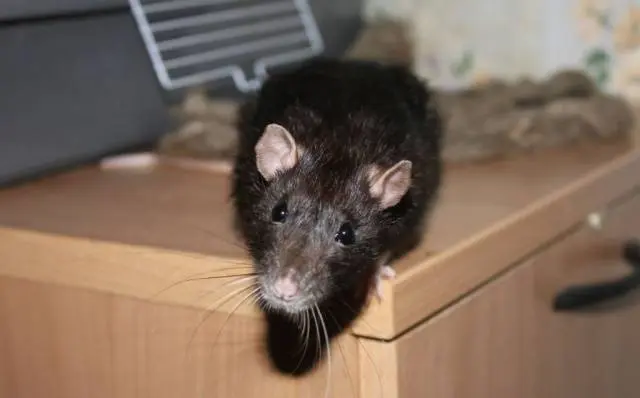
In a private house, long-tailed rodents will always find something to profit from. Animal feed, food waste, manure, chickens and rabbits – everything will fit rats in food. These rodents are even capable of eating the hooves of large animals.
Reproduction of gray rats
In a house with an abundance of food, a rat is able to bring up to 8 litters per year. In this case, in each litter there will be from 1 to 20 pups.
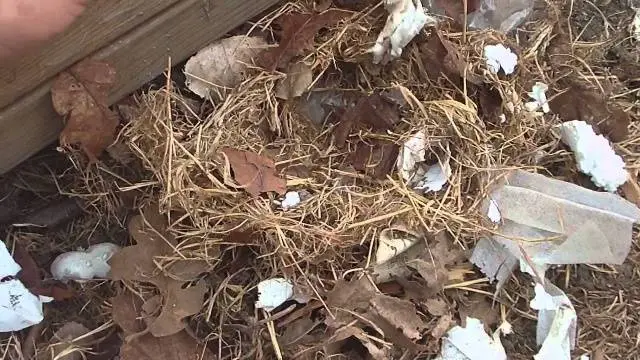
In nature, the rate of reproduction in rats is significantly reduced. These rodents are able to breed only in the warm season, so they can bring no more than 3 broods per year. You can compare the difference in the rate of reproduction of animals living in the house and in nature.
It will not be possible to permanently eliminate rats in the house. Young rodents that have grown up in another territory will leave to look for a new living space and will inevitably find your home. To completely get rid of these rodents, you need to completely exterminate the entire population of these animals, at least on the mainland. Then people will have time for a quiet life until the rodents get to the cleared space from other continents.
In part, humanity should be grateful to the rodent for this. Bigger and stronger, but less susceptible to bubonic plague, the gray migrants have supplanted a weak competitor, the black rat, the chief plague carrier in the cities.
Although the gray settlers stopped the plague, these animals are still unwanted guests in the house, since rodents have enough other diseases that are dangerous to humans. Over the centuries of coexistence, mankind has come up with many ways to get rid of rats. True, all of them turned out to be not very effective, but they allow controlling the rodent population.
Ways to deal with rats
All rodent control methods can be divided into:
- mechanical;
- chemical;
- electronic;
- biological.
In a private home, the most effective against rodents will be a mixture of mechanical and chemical methods.
How to deal with rats. (Personal experience)
“Mechanical” methods of rodent control
Among the tips on how to get rid of rats in a private house, you can find a recommendation to mix flour with gypsum and put water next to this mixture. It is believed that the rodent will eat flour, want to drink, and after the animal gets drunk, gypsum mixed with flour will harden in the rat’s intestines. In fact, rats will only eat flour when they are hungry.
A more effective way to drive rats out of the house is to find and concrete all the holes of rodents. Moreover, not sand, but crushed glass should be mixed into concrete as a filler. Sooner or later rats will gnaw through even concrete (or make moves elsewhere), but a certain number of rodents will die from crushed glass.
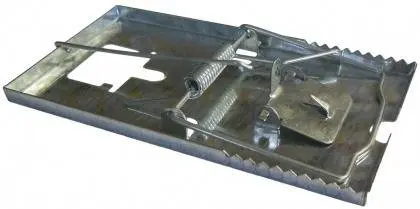
Rattraps are not as effective as we would like. At first, rats are successfully caught in them. Then the rodents realize that the free piece in the rat trap is for the second rat, and stop crawling under the striker. A similar situation is with a trap from a bucket of water and a plank on it. The first rat gets caught, the rest of the rodents will begin to avoid such an invitation to dine.
Rodent glue is even less effective than rat traps. Even mice quickly cease to fall into it. In addition, you will have to manually tear off a corpse or still a living animal. And compared to a rat trap or poison, rodent glue turns out to be more expensive and its consumption is very high, although, at first glance, the packaging of rodent glue is cheap.

Therefore, the most effective remedy for tailed rodents is still the storage of food in packaging inaccessible to rat teeth. In particular, animal feed is stored in chests upholstered with sheet iron. It is also important to maintain cleanliness in the house, when the rodents will simply have nothing to look for on the floor, table and sink.
Chemical methods of protection against rats
Actually, the chemical way to get rid of rodents is rat poison. Types of rat poisons for rodents range from fast-acting to delayed-acting drugs. Fast-acting rat poisons should not be given to rats. Smart rodents very quickly understand why relatives die and stop eating poisonous baits.

Nevertheless, poisoning rats is possible. For this, rat poisons based on anticoagulant medications are often used today. Rat poisons based on anticoagulants are a clear confirmation of the statement “no poisons and no drugs, there is a dose.” The same warfarin is prescribed to people after a stroke and fed to rats. The result is very different.
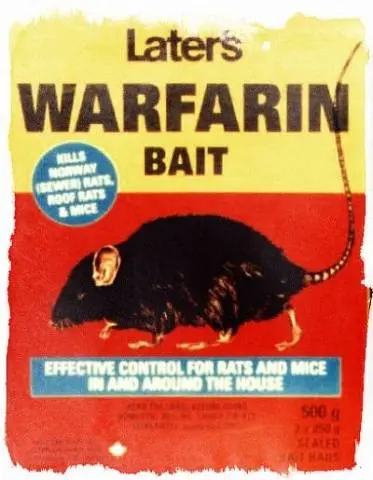
The second-generation anticoagulant Bromadiolone, which is also called super-warfarin, is already being used. It accumulates in the liver of the rat. The death of a rodent occurs only after 5 – 7 days. Other animals cannot compare the rat poison eaten a week ago with the death of a pack member.
Therefore, you need to keep poisonous baits in a place inaccessible not only to children, but also to animals. These rat baits smell very pleasantly of vanilla. Release rat poison in the form of paste, tablets or loose grain. The form of release of rat poison will need to be chosen depending on the availability for other animals of the place where the bait will be located.
In particular, it should be borne in mind that a rat can “share” a rat poison tablet, for example, with a rabbit, if the rodent decides to drag the bait into its hole, but on the way it gets scared of something and throws rat poison. Rodents will eat the grain on the spot, but chickens can peck at it. Therefore, rat poison tablets can be used in some hole, if there is confidence that the rat will not pull the rat poison tablet out, and the grain is poured behind a closed door where there is no access to pets, but where gray pests go.

In a feed warehouse, it is better to use grain or paste, putting them in a corner away from the feed. Of course, one grain that has got into the feed will not bring harm, but if there are many grains, the animals can be poisoned.
When using rat poison based on these products, keep a supply of vitamin K preparations in the house in case one of the animals decides to eat the pleasant-smelling contents of the rat poison bag. But with careful and competent use, rat poisons are a good remedy for getting rid of rats at home. In addition, the anticoagulant that has passed through the body of a rodent is no longer dangerous, even if a dead rat is eaten by a cat or dog.
Since these are slow-acting poisons, the poisoned rats will eat the new bait immediately after eating the previous one. Even as a preventive measure, a new dose of rat poison should be applied a week after the previous one has disappeared.
Electronic rodent deterrent
These are ultrasonic rodent repellers, theoretically capable of driving rats out of the house. In principle, rodent repellers are designed not only for rats, but also for mice. But rodent repellers have a lot of shortcomings due to which the devices have not gained popularity:
- ultrasound is not able to penetrate walls, so each room requires a separate rodent repeller;
- ultrasound reflects well from hard surfaces, but “gets stuck” in soft ones, so rodent repellers cannot be used in a room with upholstered furniture, they are best used in warehouses, which also does not help much if it is a warehouse with bulk feed or hay;
- rodent repellers are declared as harmless to humans and other animals, but the manufacturers of rodent repellers themselves do not recommend staying near the device for a long time (less than 2 m);
- if within 2 – 3 weeks of continuous operation of the device the rodents have not disappeared, the manufacturer of the rodent repeller offers to destroy the rats in some other way.
It’s easier to immediately apply another method of destroying rats. In addition, the practice of those who have tried to use a rodent repeller in private homes and livestock farms shows that it is useless to get rid of rodents in this way. When trying to use a rodent repeller next to other animals, it turned out that it either did not work, or that we were harassing other animals along with rats.

The latter is not surprising, since ultrasound and infrasound have the same effect on all mammals, including humans. The sound and, in some models of rodent repeller, flashes of light will have a depressing effect on any mammal on the planet. That is why the manufacturer does not advise being near the rodent repeller. But a person can finish the job and leave, turning on the device, and the animals in the barn have nowhere to go.
In addition, the rodent repeller is best suited for removing rodents from an empty room where rats have nothing to do anyway.
Biological methods how to get rats out of a private household
This is the use of natural enemies of rats. Cats are usually bred to hunt rodents. But an ordinary cat can only cope with a rat pup, which does not go outside very often. A ratcatcher capable of killing an adult rodent is highly prized in the villages and is not usually sold.
To learn how to catch rats, a kitten must live with its mother for at least six months, adopting hunting skills. And even in this case, there is no guarantee that the entire brood will catch such large rodents. Usually, kittens are distributed at 2 – 3 months, and sometimes even younger. For a 2-month-old kitten, the mother is just beginning to bring dead prey, and kittens’ teeth are not always able to cope with this game.

By 3 months, the cat brings half-strangled animals to the offspring, but the kittens are still far from a full-fledged hunt. A kitten, taken from a cat so early, simply has nowhere to learn the techniques of hunting rats. All hope is only for the presence of wild instincts in him. Such a kitten usually remains wild, not even given into hands. But much more often today among cats there is such as in the photo.
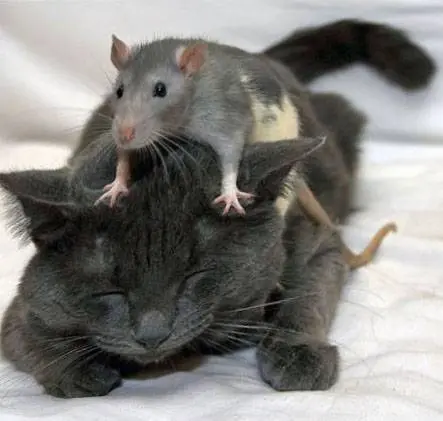
Weasels fight well with rodents. When a weasel appears in the courtyard, you can be sure that it will catch all the rats. Unfortunately, the weasel will exterminate not only wild rodents, but also poultry and rabbits. It is impossible to explain to a wild animal why it is necessary to catch only rats.

A good help in the fight against gray rodents can be a terrier that comes from a working line of hunters. Moreover, it is much easier for a dog than even for a cat to explain that only rats should be caught, without touching domestic animals.
Terriers vs. rats
And, rather, just an interesting fact, the creation of a “rat wolf”. The method was used on ships during the absence of poisons and today it looks more like sea tales. Sailors caught 1,5 – 2 dozen rodents and put them in a barrel, leaving them without water and food. These animals are cannibals by nature, and deprived of food sources, the rats began to fight among themselves until one, the strongest individual, remained. This rodent was released. Having tasted the taste of the meat of his relatives, the “rat wolf” ceased to be interested in ship supplies and began hunting for his fellow tribesmen, harassing them all from the ship. But on land, this method is hardly applicable.
Conclusion
The fight against rats in a private house is, in fact, a protracted positional war in which hardly anyone will be able to win. Therefore, the question of how to destroy rats is not even worth it. We only get rid of these animals for a while and we can partially control their reproduction. To minimize the number of rats in the house, remove all food from free access, clean the places where animals are kept so that rodents cannot feed on leftover feed, and keep rat poison in a secluded place at all times.









